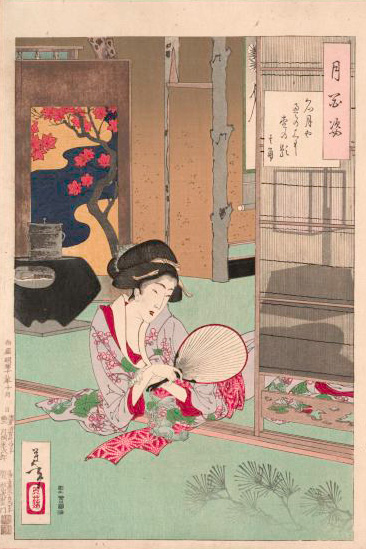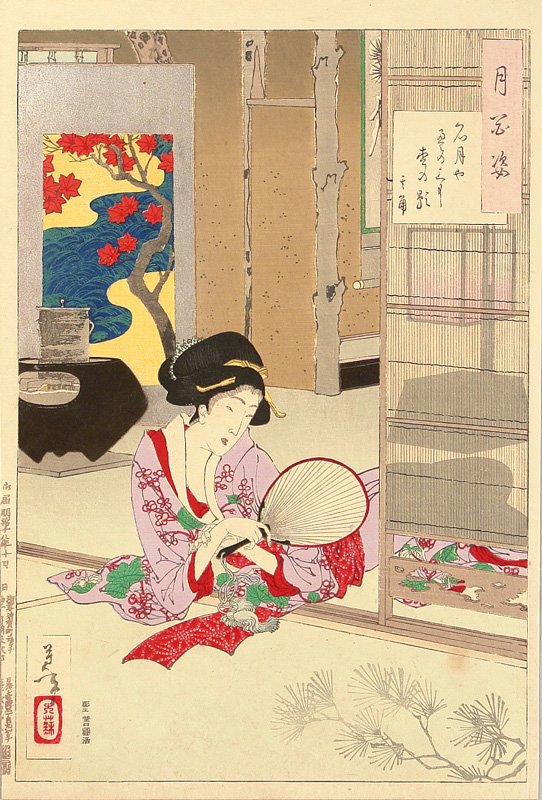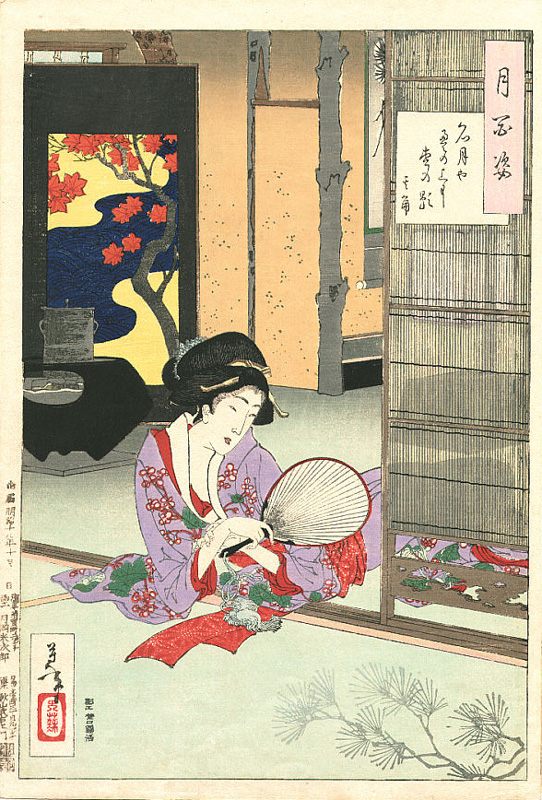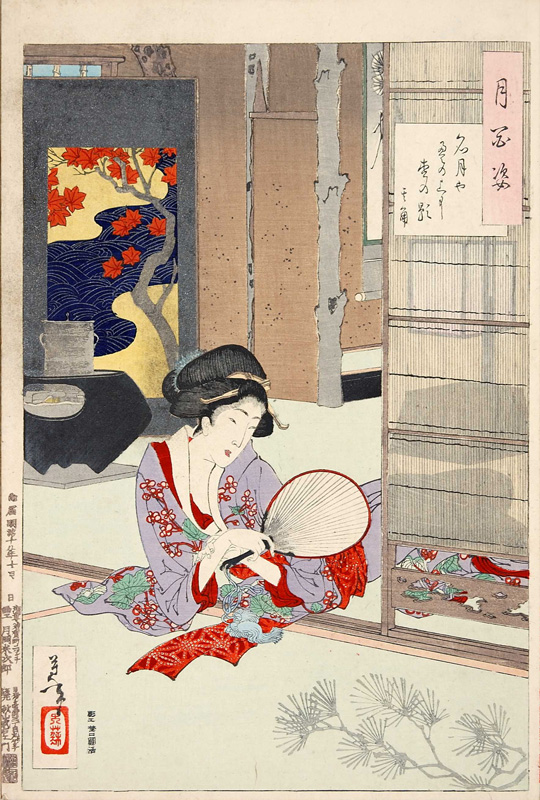About This Print
Source: Museum of International Folk Art http://www.internationalfolkart.org/exhibitions/past/moonweb/section1/001.htm
This picture illustrates a verse by Takarai Kikaku (1661-1707), a celebrated haiku master, that reads, "Full moon on the tatami mats; shadows of the pine branches."
This print is missing the lavender color normally found in the courtesan's robe and the rectangular cartouche in the upper right of the print bearing the series title has only a partial application of the light pink color normally seen in the cartouche. It is apparent from the below images that numerous states of this print exist.
| Tokyo Metropolitan Library 5233-060-076 |  Image from bound album issued shortly after Yoshitoshi's death New York Public Library Digital Gallery |
The Story Depicted in the Print as Told by John Stevenson
Source: Yoshitoshi's One Hundred Aspects of the Moon, John Stevenson, Hotei Publishing, Netherlands 2001.5.
Full moon
on the tatami mats
shadows of the pin branches – Kikaku
meigetsu ya
tatami no ue ni
matsu no kage – Kikaku
A lady looks at the shadow of pine branches thrown by a bright moon onto the straw mats of her room. That the setting is a teahouse is indicated by the furo, three-legged brazier to the left of the design, and by the rough wood pillar of the tokonoma, ceremonial alcove, to the right. But it is an unusually opulent teahouse. The screen to the left, painted in the brightly colored Rimpa style, is rather gaudy for a teahouse, and the area is large, with tatami mats extending into the foreground. It is a teahouse of the pleasure quarters, either a house where assignations are arranged, or a teahouse in a large and luxurious brothel.
The lady is probably a courtesan, though neither her robes nor her hairstyle confirm this. She wears two half-open undergarments, with her under-sash (not obi) untied and falling in front of her. Her simple hairstyle – a courtesan on duty would have many more ornaments in her hair – might be explained if she had just come from a bath. There are no suggestions that she is entertaining a customer (conventions might include smoking utensils left on the floor, or used tissues), and she is probably relaxing alone late at night.
There are more than a few hints that this design pays homage to Utamaro (1754-1806), the most celebrated designer of prints of the pleasure quarters. The lady’s hairstyle is in the fashion of the 1790s, when the dominant ukiyo-e artist was Utamaro, not in the fashion of a hundred years earlier, when the poem in the title cartouche was written. The screen is painted in the style of Utamaro’s contemporary, Sakai Hōitsu, who revived the decorative style of Ogata Kōrin at the end of the eighteenth century. Lamplight is thrown through a bamboo screen, the printing techniques for which were perfected in Utamaro’s prints. The lady holds an uchiwa, round fan (round like the moon?), which was a favorite motif of Utamaro’s. The lady is very sensual, like a figure by Utamaro, who is best known for his prints of women of the Yoshiwara caught at informal moments in their daily lives.
The season here must be early autumn. A furo was used for the tea ceremony only from May to October; during the colder months an open hearth was used. The light screen on the right would be replaced by a solid sliding panel when the weather became chilly. A rule of haiku is that the season should be indicated in the poem: the full moon, the meigetsu of the title, is associated with autumn, and this reverence is reinforced by the autumnal red maple leaves of the painted screen. This season of the dying year adds nostalgia to the design. The full moon floods the room with light, and this too adds poignancy: the lady is at the full bloom of beauty, which will fade almost as quickly as the moon wanes.
A scroll painting of pine branches, echoing the poem in the cartouche, hangs in the tokonoma. The poem is by Tarakai Kikaku (1661-1707) who was one of the most important disciples of Bashō, the greatest master of haiku poetry; a design of Bashō ends the Moon Series. Kikaku often frequented the Yoshiwara pleasure district in Edo and was a friend of the fabulously wealthy Kinokuniya Buzaemon, the only man ever rich enough to buy up every one of the Yoshiwara brothels for an evening’s entertainment – which he did twice. During a party held at the Yoshiwara during a period of drought, Kikaku was asked to compose a poem so touching that heaven would be moved to send rain. He complied, saying that there was a precedent in a poem written by the ninth-century poetess Ono no Komachi, and rain did indeed fall soon after he composed his poem. These associations with the Yoshiwara also recall Utamaro, “artist of the Green Houses,” as the Yoshiwara brothels were colloquially known.
last revision:
on the tatami mats
shadows of the pin branches – Kikaku
meigetsu ya
tatami no ue ni
matsu no kage – Kikaku
A lady looks at the shadow of pine branches thrown by a bright moon onto the straw mats of her room. That the setting is a teahouse is indicated by the furo, three-legged brazier to the left of the design, and by the rough wood pillar of the tokonoma, ceremonial alcove, to the right. But it is an unusually opulent teahouse. The screen to the left, painted in the brightly colored Rimpa style, is rather gaudy for a teahouse, and the area is large, with tatami mats extending into the foreground. It is a teahouse of the pleasure quarters, either a house where assignations are arranged, or a teahouse in a large and luxurious brothel.
The lady is probably a courtesan, though neither her robes nor her hairstyle confirm this. She wears two half-open undergarments, with her under-sash (not obi) untied and falling in front of her. Her simple hairstyle – a courtesan on duty would have many more ornaments in her hair – might be explained if she had just come from a bath. There are no suggestions that she is entertaining a customer (conventions might include smoking utensils left on the floor, or used tissues), and she is probably relaxing alone late at night.
There are more than a few hints that this design pays homage to Utamaro (1754-1806), the most celebrated designer of prints of the pleasure quarters. The lady’s hairstyle is in the fashion of the 1790s, when the dominant ukiyo-e artist was Utamaro, not in the fashion of a hundred years earlier, when the poem in the title cartouche was written. The screen is painted in the style of Utamaro’s contemporary, Sakai Hōitsu, who revived the decorative style of Ogata Kōrin at the end of the eighteenth century. Lamplight is thrown through a bamboo screen, the printing techniques for which were perfected in Utamaro’s prints. The lady holds an uchiwa, round fan (round like the moon?), which was a favorite motif of Utamaro’s. The lady is very sensual, like a figure by Utamaro, who is best known for his prints of women of the Yoshiwara caught at informal moments in their daily lives.
The season here must be early autumn. A furo was used for the tea ceremony only from May to October; during the colder months an open hearth was used. The light screen on the right would be replaced by a solid sliding panel when the weather became chilly. A rule of haiku is that the season should be indicated in the poem: the full moon, the meigetsu of the title, is associated with autumn, and this reverence is reinforced by the autumnal red maple leaves of the painted screen. This season of the dying year adds nostalgia to the design. The full moon floods the room with light, and this too adds poignancy: the lady is at the full bloom of beauty, which will fade almost as quickly as the moon wanes.
A scroll painting of pine branches, echoing the poem in the cartouche, hangs in the tokonoma. The poem is by Tarakai Kikaku (1661-1707) who was one of the most important disciples of Bashō, the greatest master of haiku poetry; a design of Bashō ends the Moon Series. Kikaku often frequented the Yoshiwara pleasure district in Edo and was a friend of the fabulously wealthy Kinokuniya Buzaemon, the only man ever rich enough to buy up every one of the Yoshiwara brothels for an evening’s entertainment – which he did twice. During a party held at the Yoshiwara during a period of drought, Kikaku was asked to compose a poem so touching that heaven would be moved to send rain. He complied, saying that there was a precedent in a poem written by the ninth-century poetess Ono no Komachi, and rain did indeed fall soon after he composed his poem. These associations with the Yoshiwara also recall Utamaro, “artist of the Green Houses,” as the Yoshiwara brothels were colloquially known.
About the Series "One Hundred Aspects of the Moon"For details about this series which consists of one hundred prints with the moon as a unifying motif, see the article on this site Yoshitoshi, One Hundred Aspects of the Moon.
Print Details
| IHL Catalog | #671 |
| Title | Full Moon on the Tatami Mats, Shadows of the Pine Brances - Kikaku (Meigetsu ya tatami no ue ni matsu no kage - Kikaku 名月や畳の上に松の影其角) |
| Series | One Hundred Aspects of the Moon (Tsuki hyaku sugata 月百姿) |
| John Stevens Reference No.* | 5 |
| Artist | Tsukioka Yoshitoshi (1839-1892) |
| Signature | Yoshitoshi 芳年 |
| Seal | Taiso 大蘇 |
| Date | October 1885 (御届明治十八年十月 日月) |
| Edition | A single sheet issue, not bound into an album. Perhaps an early state of the print, but missing the lavender color normally seen in the courtesan's robe. |
| Publisher | Akiyama Buemon (秋山武右エ門) [Marks: seal 26-132; pub. ref. 005] |
| Carver | Engraver Noguchi Enkatsu (彫工埜口円活) |
| Impression | excellent |
| Colors | excellent |
| Condition | good - two horizontal tears repaired from back in top portion of brown screen surrounding the Rimpa style scroll; not backed |
| Genre | ukiyo-e |
| Miscellaneous | |
| Format | oban |
| H x W Paper | 13 1/2 x 9 3/8 in. (34.3 x 23.8 cm) |
| H x W Image | 13 x 9 in. (33 x 22.9 cm) |
| Collections This Print | The British Museum 1906,1220,0.1459; The Tsubouchi Memorial Theatre Museum of Waseda University 201-1777 and 401-0488; Ritsumeikan University ARC NDL-541-00-079; Tokyo Metropolitan Library 加4722-76; New York Public Library Digital Gallery 1269852 |
| Reference Literature | * Yoshitoshi’s One Hundred Aspects of the Moon, John Stevenson, Hotei Publishing, Netherlands 2001, pl. 5. |
12/9/2020






